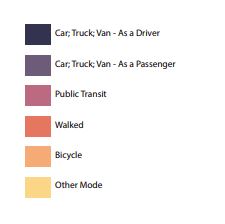D.7 Transportation Characteristics
A Note on Data Collection
Data regarding transportation modes are collected based on the modes of transportation individuals use to get to and from work. While this method does provide more consistency with the data, it assumes that individuals are likely to use their preferred mode of travel more often and does not present a complete picture of the study area. In particular, preferred travel modes of nonworking populations such as selected students, unemployed individuals, or the elderly are not included within the data. Given that the students especially are a significant population within the study area, the information on transportation modes may not be entirely reflective of the entire population.
Popular Modes of Transportation
The most common mode of commuting is by car, as a total of 66% of study area residents travel to their places of work by car either as the driver or passenger. Census Tract 29 is the only area in the study area, where the proportion of car travellers does not reach 50% of the total population. In comparison, 92% of Windsor’s population use cars to commute to their places of employment.
Active and Alternative Transportation.
Active Transportation refers to any mode of travel that involves physical movement, such as walking or biking, and it is often promoted as a way to increase physical activities and encourage more active lifestyles. In the study area, while 11% of people walk to work regularly, there are only 4% of residents that cycle to their workplaces. When examined independently, these figures may seem small. However, when compared to the entire City, where only 3% of people go to work on foot and 1% of the population bike to work, the figures of the study area would no longer be considered small.
Similarly, alternative transportation is any mode of transportation that does not involve a single car being operated by one person, thus producing less greenhouse gas per trip. In addition to the walking and cycling mentioned above, alternative transportation also includes other modes such as carpooling and taking public transportation. With higher percentages of people using alternative transportation as their primary method to get to work, the study area is more likely to have a more active population than the less walkable or transit-supportive regions in the rest of the City. Furthermore, since the residents in the study area tend to have lower incomes, alternative modes may be their only option. For example, riding public transits and walking make up almost half of all travel methods for residents travelling to and from work in Census Tract 29, an area that is dominated by students.
